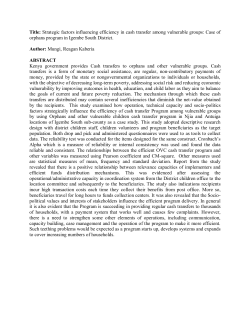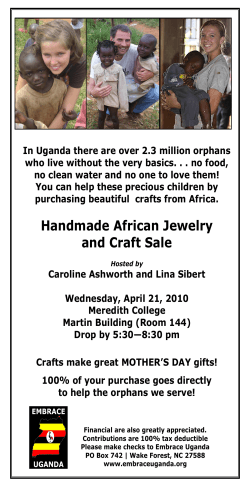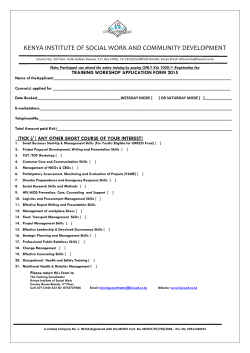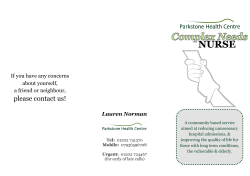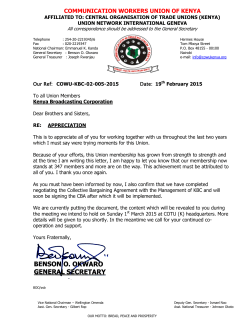
Do Orphans And Vulnerable Children Have A Future, A Critical Analysis of Community-Based Social Protection Systems In Kenya
Africa International Journal of Multidisciplinary Research (AIJMR) ISSN: 2523-9430 (Online Publication) ISSN: 2523-9422 (Print Publication), Vol. 2 (3) 59-68, May 2018 www.oircjournals.org Do Orphans And Vulnerable Children Have A Future? A Critical Analysis of Community-Based Social Protection Systems in Kenya Selina Cheptonui Kogo Moi Teaching and Referral Hospital P.O Box 3-30100, Eldoret, Kenya Type of the Paper: Research Paper. Type of Review: Peer Reviewed. Indexed in: worldwide web. Google Scholar Citation: AIJMR How to Cite this Paper: Kogo, C. S. (2018). Do Orphans And Vulnerable Children Have A Future? A Critical Analysis of Community-Based Social Protection Systems in Kenya Africa International Journal of Multidisciplinary Research (AIJMR), 2 (3), 59-68. Africa International Journal of Multidisciplinary Research (AIJMR) A Refereed International Journal of OIRC JOURNALS. © With Authors. This work is licensed under a Creative Commons Attribution-Non Commercial 4.0 International License subject to proper citation to the publication source of the work. Disclaimer: The scholarly papers as reviewed and published by the OIRC JOURNALS, are the views and opinions of their respective authors and are not the views or opinions of the OIRC JOURNALS. The OIRC JOURNALS disclaims of any harm or loss caused due to the published content to any party. 59 | P a g e Selina (2018) www.oircjournals.org Africa International Journal of Multidisciplinary Research (AIJMR) ISSN: 2523-9430 (Online Publication) ISSN: 2523-9422 (Print Publication), Vol. 2 (3) 59-68, May 2018 www.oircjournals.org Do Orphans And Vulnerable Children Have A Future? A Critical Analysis of Community-Based Social Protection Systems in Kenya Selina Cheptonui Kogo Moi Teaching and Referral Hospital Eldoret, Kenya ARTICLE INFO Abstract Globally, widespread increase of adversities such as Article History: chronic poverty and Hiv/Aids have increased the Received 4th May, 2018 number of orphans and vulnerable children, thereby threatening the realization of the Sustainable Received in Revised Form 17th May, 2018 Development Goals in spheres of Education, Health, th Accepted 24 May, 2018 Nutrition, and psychosocial development. In Kenya, Published online 25th May, 2018 the vulnerability of children communities is evident and its manifestation is in different spheres in the Keywords: Community-based Child Protection, society causing disorder and disintegration. Orphans Orphans and Vulnerable Children, Kenya and vulnerable children have been the victims of circumstance, posing a big challenge to their survival and development. Academic evidence from various studies on child protection in other countries in Africa have shown how adoption of community based child protection mechanism can effectively address child protection issues. The main question is: Is this the same case in Kenya? With use of literature information in Kenya and outside, this paper analyses the role of community-based child protection structures for the survival and development of orphans and vulnerable children. Findings of the study indicates that there is disconnect that exist between the national child protection systems and community-based child protection structures thus, threatening the future of orphans and vulnerable children. The paper argues that Kenya has done little in strengthening community-based child protection systems, which play the role of prevention and coordination of resources at the community level in addressing child protection issues. Moreover, interventions employed by various stakeholders to establish and/or strengthen child social protection systems, have achieved little and are not sustainable. The paper concludes that community based child protection structures are fundamental instruments in prevention of children vulnerabilities and create a link between children, community and national structures. The paper recommends that for community-based protection structures to be effective, a creation of collaborative effort of these structures in addressing children vulnerabilities is integral. Introduction Globally, widespread increase of adversities such as chronic poverty and Hiv/Aids have increased the number of orphans and vulnerable children, thereby threatening the realization of the Sustainable Development Goals in spheres of Education, Health, Nutrition, and psychosocial development. It is on this basis that countries have adopted various social protection interventions to address the needs of Orphans and Vulnerable Children (OVC). Social protection for Orphans vulnerable children dates back to the 16th and early 17th century in English Elizabethan Poor Laws. As early as 1948, social protection was specified in the Universal Declaration of Human Rights, with the statement that everyone has the right to social security. And the right of 60 | P a g e Selina (2018) www.oircjournals.org Africa International Journal of Multidisciplinary Research (AIJMR) ISSN: 2523-9430 (Online Publication) ISSN: 2523-9422 (Print Publication), Vol. 2 (3) 59-68, May 2018 www.oircjournals.org children to various aspects of social protection is included in the 1989 Convention on the Rights of the Child (CRC) (Gatenio & Kamerman, 2006). In this paper, social protection systems refers to communitybased child protection structures from public, private voluntary organizations and informal networks to support communities, households and individuals in their efforts to prevent, manage and overcome a defined set of risks and vulnerabilities among OVC. With the trend toward globalization beginning in the 1980s, there has been a growing recognition of the importance of social protection systems especially for the care of orphans and vulnerable children. Latin America provides an excellent source of country illustrations of social protection for the middleincome countries. Thirteen countries in the region have implemented conditional cash transfer programs, in most cases with support from the InterAmerican Development Bank (IADB) (IADB, 2006). In 2005, 5.5 million children in sub-Saharan Africa became orphans from all causes, up from 3.4 million children who were orphaned in 1990. However, by 2015 the figures went up. UNICEF (2015) shows that there were over 132 million orphans in Sub-Saharan Africa, Asia, Latin America and the Caribbean in 2005. This large figure represents not only children who have lost both parents but also those who have lost a father but have a surviving mother or have lost mother but have a surviving father. Of these 132 million categorised as orphans, 13 million of the children have lost both parents. Evidence clearly shows that the vast majority of orphans are living with a surviving parent, grandparent or other family member calling for the need to strengthen social protection systems (Pillay, 2014). Asia-Pacific is home to the greatest number of orphaned children, 75 million (State of the World's Children, 2011). Sub-Saharan Africa has been identified as the world's poorest region with the largest proportion of vulnerable children in the world. According to UNICEF (2011), Sub-Saharan Africa has the largest orphan burden with over 70 million children who have lost one or both parents. Although the HIV/AIDS epidemic is the most prevalent cause of orphan-hood, most children are orphaned by other causes such as natural disasters, conflict and other health conditions (Gulaid, 2008). In a study on the effectiveness of conditional cash transfers in reducing poverty, inequality and human capital development in developing and developed countries, Heinrich (2006) describes coverage of these programs as extensive in some countries, for example, Plan Familias in Argentina, Bolsa Familia in Brazil, and Oportunidades in Mexico, helping a total of almost 17 million families living in extreme poverty. Evaluations report positive effects on poverty as well as on school enrollment rates, grade retention, consumption levels, immunization rates, nutrition and reductions in child labor. According to World Vision, child social protection systems is a set of coordinated formal and informal elements working together to prevent and respond to abuse, neglect, exploitation and other forms of violence against children (Forbes et al, 2011). The absence of a specific coordination child protection structure for children can further marginalize them. Without such a structure, children can fall through the gaps created by the various legislations. In Eastern and Southern Africa, the number of orphans and vulnerable children throughout is growing, partly due to the death of parents from HIV and AIDS and by 2008 12 million children under the age of 18 had been orphaned by the disease. OVC remain invisible until a coordinating structure can identify and monitor them. For example, in Ethiopia, there is absence of a comprehensive coordinating structure for OVC programming (SCUK, 2004). In Kenya alone, there are over 3.6 million children aged 18 years who have been orphaned or who are vulnerable (KNBS, 2013). As HIV and AIDS epidemic becomes increasingly complex and as the personal and social consequences rise, the ways in which societies respond to ensure children’s right to quality education must become more integrated, nuanced and dynamic (KAIS, 2012). Social 61 | P a g e Selina (2018) www.oircjournals.org Africa International Journal of Multidisciplinary Research (AIJMR) ISSN: 2523-9430 (Online Publication) ISSN: 2523-9422 (Print Publication), Vol. 2 (3) 59-68, May 2018 www.oircjournals.org protection gained its first significant foothold in Kenya in 2003 when the political settlement switched from dominant to competitive clientelism during the period of increased policy space and ministerial autonomy (Wanyama & McCord, 2017). Competitive clientelism has continued to characterize the political settlement since this time, and successive regimes have continued to support the extension of social protection. Prior to 2003, social protection in Kenya was characterized by a large number of small-scale fragmented interventions providing in cash and inkind support on an ad hoc basis, implemented by a range of government and civil society actors (McCord 2006). This scenario changed following the 2003 elections, and a process of consolidation and development of state-administered national cash transfers was initiated, together with the discussion of the extension of Social Health Insurance for the poorest, also on a national basis (IPAR, 2005; Wanyama & McCord, 2017). Orphans and vulnerable children in Kenya are finding it increasingly difficult to access basic education, health and psychosocial support. This is despite the fact that children rights should be given priority because of their special needs. Efforts by child protection actors in recent years have been focused on strengthening these mechanisms, in particular at familiar communal level. With child protection interventions generally targeting contexts in which the state is unable or unwilling to provide for the protection of children, families and communities are considered to be the primary actors in protecting children and young people against exploitation. In the Kenya like other Sub-Saharan African countries, system strengthening has consistently highlighted the importance of building sustainable community-based child social protection structures that are coordinated with the wider system. This is premised on the understanding that community ownership, support of traditional leaders, existing community leadership such as Nyumba Kumi and the use of existing community resources can support the welfare of OVC. Davis & McCaffery (2012) finds that community-based child protection structures serve to address and manage issues of OVC through participation and inclusiveness. Community Child protection systems are perceived to bring together formal and non-formal institutions to address OVC issues. This paper is an outcome of a critical review of related studies on OVC social protection systems. This is important to examine the functionality of formal and non-formal child social protection structures to unravel the disconnect that exist and lead to inability of these structures to exercise child protection responsibilities. Statement of the Problem It is estimated that more than 3.6 million children in Kenya alone orphaned. Despite the challenges facing OVC, limited coordination amongst child protection actors is cited as a challenge. Akuma (2014) finds that social protection is explicitly prioritized in Vision 2030, the newly promulgated Constitution of Kenya 2010 and in the National Affirmative Action Policies. For instance, between 2005 and 2010, expenditure on social protection rose from Kshs. 33.4 billion to Kshs. 57.1 billion, which is equivalent to 2.28% GDP. Despite the increment, there is still funding constraints due to many existing vulnerabilities in the country, ineffective coordination and weak leadership in child protection frameworks, lack of commitment from stakeholders, absence of clearly defined tasks and priorities and inconsistent representation from participating agencies and community-based social protection structures. Even with these revelations, literature on social protection in Kenya shows progress in implementation of child protection frameworks, however, with a dearth of explanation on the role and/or effectiveness of community-based social protection structures for OVC. It is on this basis that this paper interrogates the efficacy of community-based child social protection structures in addressing the need of OVC in Kenya, while identifying their strengths and failures in implementing OVC interventions. Theoretical Framework 62 | P a g e Selina (2018) www.oircjournals.org Africa International Journal of Multidisciplinary Research (AIJMR) ISSN: 2523-9430 (Online Publication) ISSN: 2523-9422 (Print Publication), Vol. 2 (3) 59-68, May 2018 www.oircjournals.org This paper is based on the Livelihood Portfolio Theory Based on the Welfare Pentagon (Neubourg, 2009). The theory portrays five core institutions that support the wellbeing of OVC namely: family, markets, social networks, membership institutions and public authorities. According to the theory, individuals and households maximize income under constraints. Second, all households face the risk of becoming poor at a certain point in future. To prevent this risk, households’ consumptions should be smoothened and resources need to be set apart to finance future consumption. The ability to smoothen consumption is an important factor for OVC’s wellbeing. It is individual’s capacity to satisfy basic needs for tomorrow, despite the existence of risk and occurrence of shocks thus, social protection then becomes a consumption smoothing strategy. Households use these to satisfy their current and future needs over time. Each societal institution has a function and they are used as a livelihood strategy in order to generate income and smoothen consumption. Individuals within the society can access the welfare pentagon institutions much better if they have a certain amount of capital available. Individuals and households differ in their possibilities to invest in financial, social and political capital. This makes it important for the state to assist in promoting social protection through various social policy instruments and providing goods and services for free or at low cost. In spite of their functions, the institutions of the welfare pentagon channels are substitute for one another. This means public authorities can step in to provide social protection, just as local self-initiatives or the family can do so. It also means that if the public authorities withdraw or lower their inputs in providing social protection other channels of the welfare pentagon will have to make a greater effort to assist the household in meeting their needs. If the state does not assist in providing social protection, the burden is shifted towards individuals with higher risks and the burden is even more difficult for individuals and households with fewer resources (Neuboug, 2009). The weakness of Neuborngs theory is that it overlooks the new discourse of social protection which recognizes that in the absence of effective collective managements to manage risks, individuals and households, particularly those who are most vulnerable must be engaged in micro-level informal risk management strategies which impose very high cost of their own (Conway & Norton, 2002). In the subsequent sections, the paper discusses the concept of OVC from different perspectives, Context of Orphans and Vulnerable Children The impact of orphan hood has devastating effects on children in a number of ways. The loss of a parent either through death, abandonment or other social factors, not only has an immense emotional impact on a child but for most children, it is the beginning of a cycle of economic hardship. Collins and Leibbrandt (2007) state that; “80% of families would lose more than half their per capita income with the death of the highest income earner, suggesting a lingering and debilitating shock of death. The loss of a parent or adult caregiver can have serious consequences for a child’s access to basic necessities such as shelter, food, clothing, education and health care. Children whose parents have terminal illness may suffer neglect, including emotional neglect, long before they are orphaned. The orphans and other vulnerable children could drop out of school to work, look after siblings or due to lack of a parent to provide emotional support and encouragement desired by the child. Response to the orphans’ crisis has been driven by communities which provide a safety net for care and support of orphans and vulnerable children, caregivers and their families through the networks. However, this has been faced by challenges, which lead to incapacity of traditional family patterns due to the force of contemporary realities. Family groups are becoming internally deinstitutionalized, carrying out fewer traditional functions, and becoming smaller and more unstable. With the growing number of orphans and vulnerable children, many approaches and social protection models have been employed in trying to enhance the well-being of these children to improve their 63 | P a g e Selina (2018) www.oircjournals.org Africa International Journal of Multidisciplinary Research (AIJMR) ISSN: 2523-9430 (Online Publication) ISSN: 2523-9422 (Print Publication), Vol. 2 (3) 59-68, May 2018 www.oircjournals.org household wellbeing, but little is known about the effects of these interventions that are coined around education, food security, health and family care of the Orphans and Vulnerable children. Skinner and Davids (2006) identified multiple vulnerabilities to which children could be exposed including: HIV/AIDS and other illnesses, disability, poverty, limited access to services, physical, sexual and emotional abuse and neglect, child-headed households, violence and substance abuse within communities. Research has further indicated that, although child-rearing by family members is supportive of resilience among Kenyan OVC, there are increasing reports of child-headed families (Daniel & Mathias, 2012). Prior to being orphaned, these children care for their dying parents while responsibility changes once parents die to caring for younger siblings (Heath et al. 2014). Formation of Child Social Protection Structures In the immediate pre-independence period, social protection networking was prevalent in families and communities (Marumbasi, 2009). In its strategic paper on Social protection quoted in the Kenya government notes that ‘About 46% of the population of Kenya lives below the national poverty line while 19% live in extreme poverty. The high poverty levels are as a result of several factors including, but not limited to; natural disasters, environmental degradation, the HIV/AIDS pandemic, unemployment, a lack of income in old age and a breakdown of traditional safety net mechanisms. The Kenya Strategic Paper on Social Protection states that social protection measures such as policies and actions for the poor and vulnerable, which enhance their capacity to cope with poverty and equips them with skills to better manage risks and shocks. The four key areas in the provision of services are Education, Health, Water and sanitation (Kidd, 2007). It can also be looked at from the human rights perspective as entitlement to benefits that society provides to individuals and households to protect against low or declining living standards resulting from a number of basic risks and needs. The authors holds that protecting children is paramount in our communities if we are to nurture well our future generations. How to respond to, mitigate, and prevent risks to children’s protection and well-being is a thoughtful, and necessary to develop and strengthen protective factors at multiple levels, such as the family, community, national and international levels for the survival and development of a child. Fedha, (2017) notes that in the year 2010, Ex-street Children Community Organization (ECCO) an organization based in Eldoret working with street children and other vulnerable children realized that many children coming into the streets were from the slums around Eldoret town and devised prevention strategies to curb the menace of street children. One of the strategies was the establishment and strengthening of community-based Child Protection Committees (CBCPCs). Through the support of Save the Children UK, ECCO identified, formed and trained four Child Protection Committees in the major low income estates in Eldoret, which include Langas, Munyaka, MailiNne, Huruma and Kipkaren. The formed CBCPCs were aimed to improve the coordination of services for OVC exposed to many vulnerabilities at the grassroots as well as increasing their participation in activities affecting them. They also acted as a point of reference at the grassroots to support vulnerable children, help them understand how to identify networks and create linkages aimed at supporting OVC in the community, while enhancing their capacity to share information and best practices. To date, CBCPCs have become key local informal institutions in terms of planning and coordination of child protection work. As they are formed at the grassroots they are aware and understand the needs of the OVC they serve and direct sufficient resources to services for the care and protection of children. This model has so far been replicated by other organizations within Uasin Gishu County and beyond as a best practice. Social Protection System and Education of Orphaned and Vulnerable Children Social protection can have an impact on education by addressing the underlying economic and social 64 | P a g e Selina (2018) www.oircjournals.org Africa International Journal of Multidisciplinary Research (AIJMR) ISSN: 2523-9430 (Online Publication) ISSN: 2523-9422 (Print Publication), Vol. 2 (3) 59-68, May 2018 www.oircjournals.org causes that prevent access to school, and by improving the quality of the services provided to young students and their families (Sanfilippo et al. 2012). School feeding in particular is one of the most frequently adopted interventions since such programmes are able to address multiple objectives at the same time (Buttenheim et al., 2011). However, its overall effectiveness is related to a range of factors, including the modality of provision, the targeting and the costs (Bundy et al., 2009). In Bangladesh, Ahmed (2004) reports a 15.2 per cent difference between the gross enrolment rates of schools in rural feeding programme areas and those in control areas while in Burkina Faso, Kazianga et al. (2009) report that Girls' enrolment in rural areas increased by 5 and 6 per cent on site and take home ration, respectively following successful implementation of the WFP school feeding programme. Evidence from Colombia indicates that on-site feeding supports school enrolment of the youngest children, while take home rations have a stronger impact on attendance. School feeding has contributed to the recent increase in net enrolment in the country. It has been estimated that in schools promoting on-site feeding enrolment has increased by 2-2.5 per cent between 2002 and 2009, with a slightly greater impact recorded for girls (2.4-3% (Sanfilippo et al. 2012). From Colombia, Attanasio et al. (2005) report that Young children (10-13) in urban areas increased their time at school by 4.5 hours per day. Urban children (14-17) and rural children (10-13) increased their time at school by 3.8 and 2.5 hours, respectively. In Brazil, Veras Soares et al. (2008) posit that for treated children (7-14 years) participation in the programme reduces the probability of absence (3.6%), dropping out (1.6%) and failing to advance in school (4%). In Namibia, participation of 14 out of 16 students was solely due to their grandparents receiving a pension (Devereux, 2001). A large number of recipients of the basic income grant used the money to pay school fees. As a consequence, a decrease of 42 per cent in non-attendance due to financial reasons has been recorded and drop-out rates have fallen from 40 per cent before to almost 0 a year after the launch of the pilot programme (UNICEF, 2015). As in the case of education, existing evidence shows a more conclusive nexus between social protection and outputs including access to and utilization of health services, this being especially true for preventive services for children (DFID, 2011). Social protection programmes can facilitate access to and utilization of health services for the poor thus enhances prevention and health outcomes for the poor children (Sanfilippo et al. 2012). Results from the evaluation of a school feeding programme in Kenya show quite clearly that the contribution of school feeding accounted for about 30 to 90 per cent of the recommended daily allowances in terms of energy and protein for the majority of the students (80%), while it accounted for almost the whole intake of vitamin A in more than 20% of cases (WFP, 2010). Based on principles similar to those of school feeding, but providing households with a monthly ration of food, the ‘Food for Education’ programme in Bangladesh has contributed to improving weightfor-age for the pre-school children (6 to 60 months) of beneficiary households compared to primary school-age children not attending school (Ahmed and Del Ninno, 2002). Programmes in the form of cash transfers in general also have a positive impact, given that recipient households tend to spend much of the transfer on food (Adato and Basset, 2009; DFID, 2011). The extent to which this can have an impact on child nutrition has been found to depend on key design features including the duration of the transfer, the age of recipient (0-24 months being the most critical), and the size of transfer (Yablonski and O’Donnell, 2009). Most children exist within a family structure, which may have variations, but usually there is one person, the primary care giver, who assumes responsibility for the care of the child. Ideally, the primary carer would be an adult. Even where children live on the streets or in child-headed households, with no adult 65 | P a g e Selina (2018) www.oircjournals.org Africa International Journal of Multidisciplinary Research (AIJMR) ISSN: 2523-9430 (Online Publication) ISSN: 2523-9422 (Print Publication), Vol. 2 (3) 59-68, May 2018 www.oircjournals.org carers, they nevertheless have some group structure, and assume adult roles for the care of younger siblings and children. The child cannot be separated from its ‘family’ context, and thus the well-being of the child is dependent on the well-being of the family (Teresa, 2002). Consequently, social security benefits cannot target children in isolation, but must use their family, usually the primary care giver, as the channel for reaching the child. While it is hoped that the grant would be spent directly on the child’s needs, this cannot be tracked nor ensured, and therefore it is assumed that by increasing the household income, the well-being of the child will be automatically enhanced. A comprehensive social security system seeks to provide a package of benefits that together meet the range of needs of vulnerable persons. Thus it is not a case of either cash transfers or feeding schemes. It must be recognized that while the child’s need for good nutrition is paramount to their survival and development, it is not their only basic need. Children have the right to a minimum standard of living, housing, clothing, health and education. Thus housing schemes are essential, as are cash transfers to empower care giver to provide for the child’s range of needs (Teresa, 2002). Family support programs are grounded in a family development model that is drawn from family systems theory, as well as an ecological view of child development that assumes that children develop within families and that families function within the community (Walker, 2005). Family and community culture is regarded as a significant factor in the family support approach (Walker, 2005). Home-based caregivers may be members of a child’s family and certainly part of the community in which the family functions. Homebased caregivers are often from the same culture as the children in their care. In the country, Wanyama & McCord, 2017) notes that in relation to the clientelism that has characterized successive regimes in Kenya, social protection is tolerated and promoted in as much as it allows existing systems of patronage at all levels to be maintained and developed, and does not challenge or threaten existing systems of resource control—for example, though changed ministerial mandates or enhanced transparency. Notwithstanding, a commitment to redress past inequalities and ongoing poverty on some parts, in this context power policymaking will not necessarily have a long-term ideologically driven perspective, unless it is associated with the ongoing identification of additional resource flows and/or the maintenance of meaningful patronage opportunities. Coordination of Efforts by Various Child Protection Structures The study found that there exist government children department at the County level that is currently coordinated by the Children County coordinator who also ensures that District children officers and their assistants perform child protection duties as bestowed to them. It was established that for the government to coordinate well children activities at the grassroots level, they formed Area Advisory Councils to work in tandem with the provincial administration. His was on the basis that all communities have various child protection issues that need enormous support. This led to non-governmental organizations with other stakeholders including the government to devise strategies that supplement the government activities on child protection. Hence, the formation of auxiliary structures such as child protection committees, Locational Orphans Committee (LOC) and volunteer children Officers which has recently been adopted by the government. To ensure all children are protected by national and international law against violence and abuse, these structures are taken into various child protection trainings that help them to learn about child rights and how to respond to various child protection issues such as how to categorize vulnerable children, how to identify abused children, symptoms of abused children, and how to address vulnerable children concerns. The study found that although most traditional mechanisms such as extended families 66 | P a g e Selina (2018) www.oircjournals.org Africa International Journal of Multidisciplinary Research (AIJMR) ISSN: 2523-9430 (Online Publication) ISSN: 2523-9422 (Print Publication), Vol. 2 (3) 59-68, May 2018 www.oircjournals.org addressing child protection issues have broken down, non-governmental organizations actors remain committed to serving local communities and institute local child protection structures that will most likely remain long after donor funds have ended. These child protection systems are capacity build to bring together formal and non-formal elements in a sufficient and coordinated manner. From the forgoing discussion, there exist disconnect between the local and national child protection mechanisms that threaten the future of vulnerable children. For example, it is rare for the national government to give resources to support local structures such as Area Advisory Councils in order to address the needs of vulnerable children. For instance, Fedha (2017), revealed that most volunteer children protection committee members volunteer most of their time and mobilise their own resources to support vulnerable children. There is lack of political will and coordination of efforts in addressing child protection issues. Therefore, not much has been done to strengthen community child protection mechanisms, which play the role of prevention and coordination of resources at the community level in addressing child protection issues. More and above, interventions employed by various stakeholders to establish and/or strengthen child social protection systems, have achieved little and are not sustainable without full support from the central government. Some of the interventions have been blamed on employing approaches that are not reflective of the needs of OVC hence fail to make positive impact. Achieving Success in Child Social Protection Community-based child social protection systems form an integral part of the response to ensuring that the needs of OVC are addressed adequately. Communities have continued to be the backbone of providing support to vulnerable children in the context of HIV and AIDS, even when community structures are stretched and resources limited. Communities often take it upon themselves to provide as much support as possible, regardless of whether they have been mandated or not by legal frameworks, or even assisted by donors, national and international organizations and the government. In Kenya and similar to South Africa, it has also been recognized that resources need to be channeled to the community level in order to reinforce and strengthen community action (De Bruin Cardoso, 2010). This is evidenced in current OVC programming guidelines and models in Kenya, which frequently stress the central role of communities in mitigating the impacts of HIV/AIDS on vulnerable children and their families. Conclusion and Recommendations OVC vulnerability in most Kenyan communities is evident. Its manifestation in different spheres is an implication of widespread disorders in the society activated by poverty, family breakdown, wars, displacement, sexual exploitation, HIV/AIDS among others. One of the interventions that can address child protection issues at the grassroots is the adoption of community based child social protection structures. Research and academic evidences from various studies on child protection in developing countries and particularly Kenya have shown that adoption of these mechanisms can effectively address child protection issues. However, there exist disconnect between the local and national child protection mechanisms hence failure to address child protection concerns. I therefore, recommend that for community based child protection structures to be effective, a creation of collaborative networks and coordination of these mechanisms from the national to the local level in addressing children vulnerabilities is paramount. Additionally strategies that can be employed at the community level should include advocacy, community action, providing services and resources and also participate in policy formulation. References Adato, M. and Bassett, L. (2009). Social Protection to Support Vulnerable Children and Families: The Potential of Cash Transfers to Promote Education, Health and Nutrition’. AIDS Care 21 (1): 60-75. Ahmed, A. (2004). Impact of Feeding Children in School: Evidence from Bangladesh. Washington DC, IFPRI. 67 | P a g e Selina (2018) www.oircjournals.org Africa International Journal of Multidisciplinary Research (AIJMR) ISSN: 2523-9430 (Online Publication) ISSN: 2523-9422 (Print Publication), Vol. 2 (3) 59-68, May 2018 www.oircjournals.org Ahmed, A. and Del Ninno, C. (2002). The Food for Education Program in Bangladesh: an evaluation of its impact on educational attainment and food security. FCND Discussion Paper, no. 138. Washington DC, IFPRI. De Bruin Cardoso, I. (2010). National Plan of Action for Orphans and Vulnerable Children Establishing, reviewing and implementing National Plans of Action for Orphans and Vulnerable Children in Southern and East Africa: Lessons learnt and challenges: Save the Children UK. Devereux, S., Sabates-Wheeler, R., Tefera, M. and Taye, H. (2006). Ethiopia’s Productive Safety Net Programme (PSNP): Trends in PSNP Transfers within Targeted Households. Brighton, IDS. DFID. (2011). Cash Transfers Evidence Paper, Policy Division, Department for International Development, London. Available at: http://webarchive.nationalarchives.gov.uk/+/ http://w ww.dfid.gov.uk/Documents/publications1/ cash- transfers-evidence-paper.pdf Fedha, L. M. (2017). “The Future of Orphans and Vulnerable Children: An interrogation of Community Based Child Protection Mechanisms in Eldoret Uasin Gishu CountyKenya”. International Journal of Advanced Scientific Research & Development (IJASRD), 04 (05/I), pp. 01 – 07. Forbes, B. and Lau, D., Oswald, E. Tutnejevic, T. (2011). A systems approach to child protection: A World Vision discussion paper. Monrovia, CA: World Vision International. Gatenio-Gabel, S. and Kamerman, S.B. (2006). Investing in Children, in Social Service Review, June, 2006. IPAR. (2005). ‘Social Health Insurance Scheme for All Kenyans: Opportunities and Sustainability Potential’. Institute for Policy Analysis and Research Policy Brief, 11(2): 1–4 Kenya National Bureau of Statistics (KNIBS). (2009). Population Census. Government Printer, Nairobi. Kenya National Bureau of Statistics (KNBS) (2013). Exploring Kenya’s Inequality: Pulling Apart or Pooling Together? Nairobi: Kenya National Bureau of Statistics and Society for International Development. Mildred, L. (2017). The Future of Orphan and Vulnerable Children: An interrogation of Community Based Child Protection Mechanisms in Eldoret Uasin Gishu CountyKenya. Neubourg, C.D. (2009). A Livelihood Portfolio theory of social protection; Maastricht Graduate School of Governance, Maastricht University, Brussels, December 9th, 1-5. Save the Children UK South Africa Programme, (2004). ThusaniBana–Child Responsive Integrated Support Project–Phase 1: South Africa. Sanfilippo, M., de Neubourg, C. and Martorano B. (2012). The Impact of Social Protection on Children: A review of the literature. Working Paper 2012-06, UNICEF Office of Research, Florence. Stopler, L. (2007). Hidden Shame: Violence against children with disabilities in East Africa.Terre des Hommes Nederland. Teresa, G. (2002). Assessing the Impact of the Child Support Grant on the Well-being of Children in South Africa: A Summary of available evidence. Children’s Institute, University of Cape Town. July 2002. UNICEF, (2008). Summary of Highlights: UNICEF Global Child Protection Systems Mapping Workshop. Bucharest, Romania. UNICEF, (2015). Statistics of Orphans and Vulnerable children in the Worldwide. New York. Walker, S. (2005). Family-centered principles applied to research and program support to family, friend and neighbor child care providers. Paper presented at the annual conference of the National Association for the Education of Young Children, Washington, DC. Yablonski, J., and O’Donnell, M. (2009). Lasting Benefits: The role of cash transfers in tackling Child Mortality. London, Save the Children UK. 68 | P a g e Selina (2018) www.oircjournals.org
© Copyright 2025
